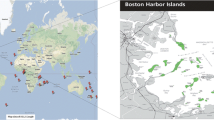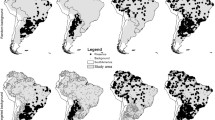Abstract
The worldwide spread of invasive species affects native biodiversity and causes economic loss, but also allows better understanding of historical biogeographic patterns. Prediction of likely invaders facilitates economic and conservation decisions and gives insight into characteristics that have allowed natural colonization over evolutionary time. However, it is not clear what types of characters best predict naturalization or even whether naturalization is predictable at all. Squamate reptiles have been understudied subjects for invasion biology. Lizards of the genus Anolis have been highly successful colonizers both recently and over evolutionary time. Nineteen of the approximately 350 described species of Anolis have established naturalized populations. We constructed models of naturalization using morphological, distributional, anthropogenic, and phylogenetic characters and compared these single character class models to each other and to a composite model incorporating all four classes. We show that (1) each class of variables significantly predicts invasion, (2) a composite model significantly outperforms each of the submodels, and (3) the final composite model displays extraordinary ability to objectively identify naturalized species of Anolis.
Similar content being viewed by others
References
Alcaraz C, Vila-Gispert A, Garcia-Berthou E (2005) Profiling invasive fish species: the importance of phylogeny and human use. Divers Distrib 11:289–298
Allen CR (2006) Predictors of introduction success in the South Florida avifauna. Biol Invasions 8:491–500
American Association of Port Authorities (2006) [WWW document] URL http://aapa-ports.org
Avila-Pires TCS (1995) Lizards of Brazilian Amazonia. Zoologische Verhandelingen
Blackburn TM, Duncan RP (2001) Determinants of establishment success in introduced birds. Nature 414:195–197
Bomford M, Kraus F, Barry SC, Lawrence E (2009) Predicting establishment success for alien reptiles and amphibians: a role for climate matching. Biol Invasions 11:713–724
Brown RP, Thorpe RS (1991) Within-island microgeographic variation in body dimensions and scalation of the skink Chalcides sexlineatus, with testing of causal hypotheses. Biol J Linn Soc 44:47–67
Campbell TS, Echternacht AC (2003) Introduced species as moving targets: changes in body sizes of introduced lizards following experimental introductions and historical invasions. Biol Invasions 5:193–212
Enserink M (1999) Biological invaders sweep in. Science 285:1834–1836
Felsenstein J (1985) Confidence limits on phylogenies: an approach using the bootstrap. Evolution 39:783–791
Fenesi A, Botta-Dukát Z (2010) Do short-lived and long-lived alien plant species differ regarding the traits associated with their success in the introduced range? Biol Invasions 12:611–623
Garcia LV (2004) Escaping the Bonferroni iron claw in ecological studies. Oikos 105:657–663
Goodwin BJ, McAllister AJ, Fahrig L (1999) Predicting invasiveness of plant species based on biological information. Conserv Biol 13:422–426
Hallstan S, Grandin U, Goedkoop W (2010) Current and modeled potential distribution of the zebra mussel (Dreissena polymorpha) in Sweden. Biol Invasions 12:285–296
Hayes KR, Barry SC (2008) Are there any consistent predictors of invasion success? Biol Invasions 10:483–506
Horton DR (1972) Lizard scale size and adaptation. Syst Zool 21:441–443
Jeschke M, Strayer DL (2006) Determinants of vertebrate invasion success in Europe and North America. Global Change Biol 12:1608–1619
Jiang L, Tan J, Pu Z (2010) An experimental test of Darwin’s naturalization hypothesis. Am Nat 175:415–423
Johnson JD, Webb RG, Flores-Villela OA (2001) Mesoamerican herpetology: systematics, zoogeography, and conservation. The University of Texas at El Paso, El Paso
Kohler G (2008) Reptiles of Central America, 2nd edn. Herpeton, Offenbach, Germany
Kolbe JJ, Glor RE, Rodriguez Schettino L, Chamizo Lara A, Larson A, Losos JB (2004) Genetic variation increases during biological invasion by a Cuban lizard. Nature 431:177–181
Kolbe JJ, Glor RE, Rodríguez Schettino L, Chamizo Lara A, Larson A, Losos JB (2007a) Multiple sources, admixture, and genetic variation in introduced Anolis lizard populations. Conserv Biol 21:1612–1625
Kolbe JJ, Larson A, Losos JB (2007b) Differential admixture shapes morphological variation among invasive populations of the lizard Anolis sagrei. Mol Ecol 16:1579–1591
Kolbe JJ, Larson A, Losos JB, de Queiroz K (2008) Admixture determines genetic diversity and population differentiation in the biological invasion of a lizard species. Biol Lett 4:434–437
Kraus F (2009) Alien reptiles and amphibians, a scientific compendium and analysis. Springer, New York
Lake JC, Leishman MR (2003) Invasion success of exotic plants in natural ecosystems: the role of disturbance, plant attributes and freedom from herbivores. Biol Conserv 117:215–226
Lever C (2003) Naturalized reptiles and amphibians of the world. Oxford Univ Press, New York
Lockwood JL (1999) Using taxonomy to predict success among introduced avifauna: relative importance of transport and establishment. Conserv Biol 13:560–567
Losos JB (2009) Lizards in an evolutionary tree: ecology and adaptive radiation of Anoles. University of California Press, Berkeley and Los Angeles
Losos JB, de Queiroz K (1997) Evolutionary consequences of ecological release in Caribbean Anolis lizards. Biol J Linn Soc 61:459–483
Losos JB, Glor RE, Kolbe JJ, Nicholson K (2006) Adaptation, speciation, and convergence: a hierarchical analysis of adaptive radiation in Caribbean Anolis lizards. Ann Missouri Bot Gard 93:24–33
Malhotra A, Thorpe RS (1991) Microgeographic variation in Anolis oculatus, on the island of Dominca, West Indies. J Evol Biol 4:321–335
Marco A, Lavergne S, Dutoit T, Bertaudiere-Montes V (2010) From the backyard to the backcountry: how ecological and biological traits explain the escape of garden plants into Mediterranean old fields. Biol Invasions 12:761–779
Mondor EB, Tremblay MN, Messing RH (2007) Morphological and ecological traits promoting aphid colonization of the Hawaiian Islands. Biol Invasions 9:87–100
Nicholson KE, Glor RE, Kolbe JJ, Larson A, Hedges SB, Losos JB (2005) Mainland colonization by island lizards. J Biogeogr 32:929–938
Nixon K (1999) The parsimony ratchet, a new method for rapid parsimony analysis. Cladistics 15:407–414
O’Connor RJ (1986) Biological characteristics of invaders among bird species in Britain. Phil Trans R Soc Lond 314:583–598
Poe S (2004) Phylogeny of anoles. Herp Mono 18:37–89
Posada D, Crandall KA (1998) MODELTEST: testing the model of DNA substitution. Bioinformatics 14:817–818
Pyšek P (1998) Is there a taxonomic pattern to plant invasions? Oikos 82:282–294
Rejmanek M, Richardson DM (1996) What attributes make some plant species more invasive? Ecology 77:1655–1661
Richardson DM, Rejmánek M (2004) Invasive conifers: a global survey and predictive framework. Divers Distrib 10:321–331
Richardson DM, Pyšek P, Rejmanek M, Barbour MG, Panetta FD, West CJ (2000) Naturalization and invasion of alien plants: concepts and definitions. Divers Distrib 6:93–107
Savage JM (2002) The amphibians and reptiles of Costa Rica: A herpetofauna between two continents, between two seas. The University of Chicago Press, Chicago, IL
Sax DF, Stachowicz JJ, Brown JB, Bruno JF, Dawson MN, Gaines SD, Grosberg RK, Hastings A, Holt RD, Mayfield MM, O’Conner MI, Rice WR (2007) Ecological and evolutionary insights from species invasions. Trends Ecol Evol 21:465–471
Schoener TW (1969) Size patterns in West Indian Anolis lizards: I. Size and species diversity. Syst Zool 18:386–391
Schoener TW, Gorman GC (1968) Some niche differences in three Lesser Antillean lizards of the genus Anolis. Ecology 49:819–830
Schwartz A, Henderson RW (1991) Amphibians and reptiles of the West Indies: descriptions, distributions, and natural history, 1st edn. University of Florida Press, Florida
Sokal RR, Rohlf FJ (1995) Biometry, 3rd edn. W.H. Freeman and Company, New York
Strauss SY, Webb CO, Salamin N (2006) Exotic taxa less related to native species are more invasive. Proc Natl Acad Sci USA 103:5841–5845
Swofford DL (2002) Paup*: phylogenetic analysis using parsimony (* and other methods). Sinauer, Sunderland
R Core Development Team (2008) R: a language and environment for statistical computing. The R Foundation for Statistical Computing, Vienna, Austria. URL http://www.R-project.org
Webb CO, Ackerly DD, Kembel SW (2007) Phylocom: software for the analysis of community phylogenetic structure and community character evolution. Version 3.41. [WWW document] URL http://www.phylodiversity.net/phylocom/
Whittingham MJ, Stephans PA, Bradbury RB, Freckleton RP (2006) Why do we still use stepwise modeling in ecology and behaviour? J Anim Ecol 75:1182–1189
Williams EE (1969) The ecology of colonization as seen in the zoogeography of anoline lizards on small islands. Quart Rev Biol 44:345–389
Williams EE (1983) Ecomorphs, faunas, island size, and diverse end points in island radiations of Anolis. In: Huey RB, Pianka ER, Schoener TW (eds) Lizard ecology: studies of a model organism. Harvard University Press, Cambridge, pp 326–370
Williams EE, Rand H, Rand AS, O’Hara RJ (1995) A computer approach to the comparison and identification of species in difficult taxonomic groups. Brevoria 502:1–47
Williamson MH, Fitter A (1996) The characters of successful invaders. Biol Conserv 78:163–170
Zabin CJ, Zardus J, Pitombo FB, Fread V, Hadfield MG (2007) A tale to three seas: consistency of natural history traits in a Caribbean-Atlantic barnacle introduced to Hawaii. Biol Invasions 9:523–544
Acknowledgments
We thank Cam Webb for help with Phylocom. Jim Brown and Mason Ryan reviewed earlier versions of this manuscript and provided useful comments. This work was supported by National Science Foundation Grant DEB-0844624 to Steven Poe and a University of New Mexico Student Research Allocation Committee Grant to Ian Latella.
Author information
Authors and Affiliations
Corresponding author
Rights and permissions
About this article
Cite this article
Latella, I.M., Poe, S. & Tomasz Giermakowski, J. Traits associated with naturalization in Anolis lizards: comparison of morphological, distributional, anthropogenic, and phylogenetic models. Biol Invasions 13, 845–856 (2011). https://doi.org/10.1007/s10530-010-9873-x
Received:
Accepted:
Published:
Issue Date:
DOI: https://doi.org/10.1007/s10530-010-9873-x




